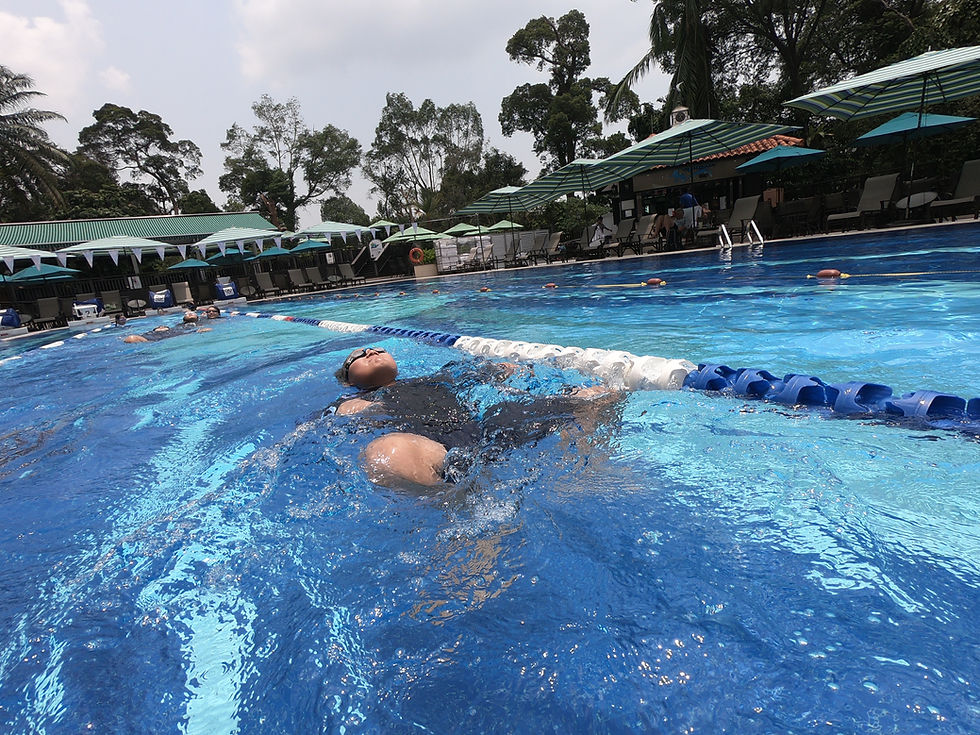Managing Emergencies and Safety Concerns in Swim Lessons
- SG Sink Or Swim

- 4 days ago
- 4 min read

Preparedness, Prevention, and Response — Keeping Every Swimmer Safe in the Water
Swim lessons are a joyful, life-enhancing experience — but they also carry inherent risks. From slips on the deck to near-drowning incidents, emergencies can arise in seconds. For instructors, coaches, and program directors, safety isn’t just a priority — it’s the foundation of everything you do.
Being prepared doesn’t just save lives — it builds trust, prevents panic, and ensures that every lesson remains a positive, empowering experience.
In this guide, we’ll cover the essential protocols, prevention strategies, and emergency response steps to manage safety concerns in swim lessons — from minor scrapes to life-threatening situations.
🚨 The Reality: Why Emergency Preparedness Matters
Drowning is the leading cause of unintentional injury death for children ages 1–4 (CDC)
70% of drowning deaths happen during non-swim times — but lessons are high-risk due to water access
Even experienced programs face slips, medical episodes, or behavioral crises
“You don’t need to be a hero. You need to be ready.”
🛡️ Prevention: Your First Line of Defense
1. Strict Supervision Protocols
“Touch Supervision”: For non-swimmers and toddlers — instructor within arm’s reach
1:4 Ratio Max: For beginners (1 instructor per 4 students)
Zone Coverage: In group lessons, assign each instructor a specific lane or area
No Blind Spots: Position yourself where you can see every student at all times
✅ Rule: *Eyes on swimmers — not on your phone, clipboard, or other instructors.
2. Clear Safety Rules (Taught & Enforced)
Post and review rules every lesson:
“Walk, don’t run” on deck
“Sit on the edge — no jumping” unless instructed
“Raise your hand if you need help”
“Stay in your lane or area”
💡 Use visual aids (icons, colors) for nonverbal or young learners.
3. Pre-Lesson Screening
Health check: No fever, vomiting, diarrhea, or open wounds
Medical alerts: Know about asthma, seizures, allergies, or autism
Emotional readiness: Is the child overly anxious or combative? Adjust or delay if needed
📋 Keep emergency contacts and medical info readily accessible — not in a locked office.
4. Safe Facility & Equipment
Non-slip deck surfaces
Clear pool edges (no toys, ropes, or obstacles)
Working safety equipment:
Reaching poles
Life rings
First aid kit (waterproof, stocked)
AED (Automated External Defibrillator)
Proper water chemistry & temperature
🆘 Emergency Response: The 4-Step Action Plan
Step 1: Recognize the Emergency
Signs of Distress:
Active Drowning: Vertical position, head low, gasping, no forward motion
Passive Drowning: Floating face-down, motionless
Medical Emergency: Seizure, fainting, allergic reaction
Behavioral Crisis: Panic, aggression, non-compliance leading to risk
⚠️ Drowning is silent — no splashing, no yelling. Watch for stillness.
Step 2: Activate Emergency Response
Shout: “I need help! Emergency at Lane 2!” (Name the location)
Assign roles:
“You — call 995!”
“You — get the AED!”
“You — clear the pool!”
Never leave a distressed swimmer alone
📞 Know your facility’s emergency number and address by heart.
Step 3: Provide Immediate Care
For Drowning/Near-Drowning:
Remove from water safely (use rescue tube if trained)
Check responsiveness: Tap shoulder, shout “Are you okay?”
If unresponsive:
Start CPR (30 compressions : 2 breaths)
Use AED as soon as available
If responsive:
Keep warm, calm, and sitting upright
Monitor for delayed symptoms (coughing, fatigue, confusion)
🩺 Even if the child seems fine, they must be evaluated by a medical professional — secondary drowning can occur hours later.
Step 4: Document & Debrief
Complete an incident report within 24 hours
Notify parents/guardians immediately
Hold a staff debrief: What went well? What can improve?
Review and update protocols
🧠 Special Scenarios & How to Handle Them
🔹 Panic or Refusal to Participate
Do: Stay calm, offer choices, validate feelings (“It’s okay to feel nervous”)
Don’t: Force, shame, or ignore
Prevent: Build trust with gradual exposure and play-based learning
🔹 Seizure in Water
Support head above water
Guide gently to edge
Do not restrain
Call 995 immediately
🔹 Slip/Fall on Deck
Assess for head/neck injury — do not move if suspected
Apply ice to swelling
Monitor for concussion symptoms
🔹 Allergic Reaction (e.g., to pool chemicals)
Rinse skin with fresh water
Administer epinephrine if prescribed
Call 995
📚 Essential Training for All Staff
✅ CPR & First Aid Certification (renewed every 2 years)
✅ Lifeguard Certification (for all instructors in deep water)
✅ Emergency Action Plan (EAP) Drills (practice quarterly)
✅ Child Safety & Abuse Prevention Training (e.g., Safe Sport)
💡 Run surprise “mock emergency” drills — they reveal gaps in real time.
💬 What Parents Should Know
Ask: “What’s your emergency action plan?”
Ensure your child’s medical info is updated
Teach your child: “If you fall in, roll to your back and float”
Never assume “they know how to swim” = “they’re drown-proof”
Final Thoughts
Safety in swim lessons isn’t about fear — it’s about freedom. When swimmers feel secure, they take risks, try new skills, and fall in love with the water. And when instructors are prepared, they teach with confidence, not anxiety.
So train hard.Plan thoroughly.Stay vigilant.
Because every splash should lead to joy —not tragedy.
See it. Prevent it. Stop it. Save them.
In the water, safety isn’t optional — it’s the first stroke of every lesson. 💙🏊♀️





Comments